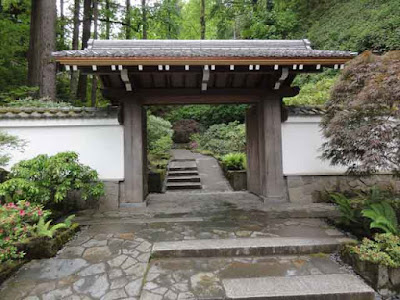The Portland Japanese Garden, set in the hills overlooking the city,
provides a peaceful refuge for those seeking rest in an atmosphere of
tranquility. Follow me to see what grows behind the garden wall.
To heal the wounds of war.
After the horrors of World War II, a number of Japanese gardens were
planned in the United States as a way to heal the wounds of war,
provide citizens with beautiful gardens, and promote cultural
understanding. Portland Japanese Garden was one of those. Planning
began about twelve years after the end of the Pacific War. It was hoped that
“needing no translation, an American could experience firsthand
Japanese ideals and values, communicated simply through nature.”
Perhaps the irony was not lost on Allied veterans.
The idea was conceived by Mayor
Terry Schrunk and other citizens of Portland. The chosen
site was the original Washington
Park Zoo. A few remnants of the old zoo remain. For example, the
present-day koi pond was formerly the zoo’s original
bear pit. In fact, the zoo began as a bear pit where unwanted
bears were captured in the interest of public safety, and penned for
public amusement. (Mayor
Schrunk, once accused of perjury related to labor-racketeering,
managed to avoid being penned.)
According to the garden’s literature, “The site was dedicated in 1961, and Professor Takuma Tono of Tokyo Agricultural University was retained to design the Garden. Professor Tono’s plan included five different garden styles laid out on 5.5 acres. This was quite a departure from gardens in Japan which typically follow one singular style. His intention was to represent different historical developments in Japanese garden architecture and through that communicate Japanese culture to create a cultural exchange.” Professor Tono was one of the most revered landscape architects of his time in Japan.
According to the garden’s literature, “The site was dedicated in 1961, and Professor Takuma Tono of Tokyo Agricultural University was retained to design the Garden. Professor Tono’s plan included five different garden styles laid out on 5.5 acres. This was quite a departure from gardens in Japan which typically follow one singular style. His intention was to represent different historical developments in Japanese garden architecture and through that communicate Japanese culture to create a cultural exchange.” Professor Tono was one of the most revered landscape architects of his time in Japan.
The garden was
finally opened to the public in 1967, though some portions were not
completed until May 18, 1980. The completion was celebrated with some fanfare, but Mount
St. Helens overshadowed the event with a big bang of its own.
A great deal has
been written about Portland’s Japanese Garden, so there’s no
point in reiterating much, but to say that the garden now consists of eight different Japanese garden styles on 12 acres. Some are pictured below.
I must remark that the staff people were very pleasant, and the docent who guided our tour was exceptionally knowledgeable and agreeable. She was, of course, an avid gardener with a great deal of personal experience to draw upon.
I must remark that the staff people were very pleasant, and the docent who guided our tour was exceptionally knowledgeable and agreeable. She was, of course, an avid gardener with a great deal of personal experience to draw upon.
Here are some of my
photographs, with a few comments. Click on the images to enlarge them.
Trees such as this Japanese Maple (Acer palmatum) are carefully pruned to create negative space. Negative space becomes as much a feature of interest as the tree itself.
The Sand and Stone Garden, seen from above. Zen gardens make use of sand, gravel and larger rocks to recreate natural scenes. Swirling patterns in sand suggest motion of water. Larger rocks suggest islands and mountains.
This lovely vista from the Strolling Pond Garden is probably one of the most photographed in the garden. When the docent said so, everyone snapped a picture, which further established its status.
A view back across the water feature shown above.
The Flat Garden.
The beautiful wisteria arbor is supported by concrete posts molded with the texture of wood.
May is an ideal time to visit the Portland Japanese Garden when azaleas and rhododendrons are in bloom.
Viburnum in bloom with Japanese maples.
A multi-tiered stone lantern set in a mossy lawn.
If planning to visit Oregon, the Portland Japanese Garden should be included in your itinerary. For visitors and residents of the city, the garden affords a unique opportunity to escape the insanity below.
Return to GoGardenNow.com.
Return to GoGardenNow.com.

























2 comments:
Excellent article. If I ever get to Portland, I shall certainly visit the Japanese Garden.
In an attempt to understand the aesthetics of Japanese culture, I have read many books and articles. The famous essay In Praise of Shadows by Junichiro Tanazaki revealed more of the mystery of Japanese sense of beauty than anything I have ever read.
Always enjoy your articles.
William McNeill
Thanks. I appreciate your comment. I'll check out In Praise of Shadows.
Post a Comment